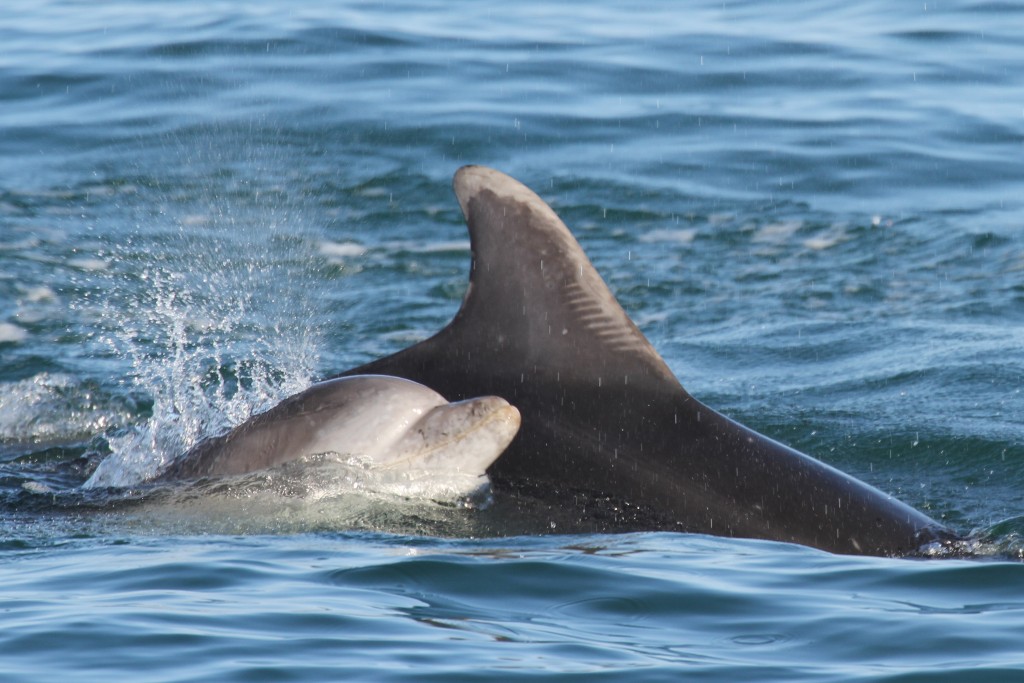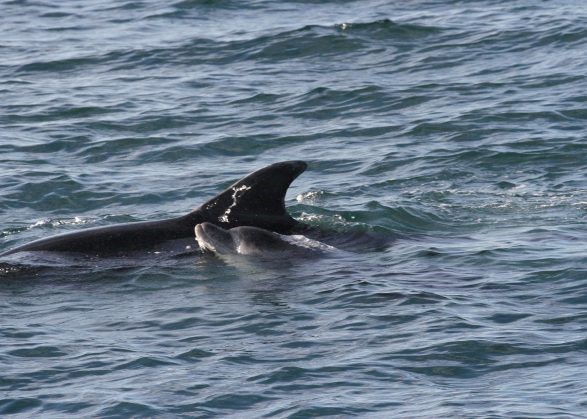Research has shown that pregnancy in Bottlenose dolphins lasts twelve months and while there is no set rule in terms of seasonality, the splash of young fins in the UK usually occurs during the summer months, most often between March and September.
There is very little room in the uterus for a baby dolphin to develop. As a result, and to make birth easier, the tail fluke and dorsal fin are cartilaginous and are folded over in the uterus. When they are born both the tail fluke and the dorsal fin will be floppy but will gradually stiffen over time. The young dolphin will have foetal folds which look like long stripes running down their body when it is first born but these will fade over time.
When the new calf finally emerges he or she will be 1 metre long and be birthed tail first. During the delivery, another female dolphin will act like a midwife to help ensure that the new-born reaches the surface to take its first breath. If the calving process has exhausted her the ‘dolphin midwife’ will also help the mother reach the surface so she can breathe too. As far as we know today, the birth of a dolphin in the wild has never been observed. All we know about the dolphin birthing process has been learned by our observation of captive animals.
The new calf will suckle for around 18-20 months and as a result the mother typically wont breed again for 2-3 years and in some cases the female hasn’t had another calf for up to 6 years after. If the calf is male he won’t be sexually mature until he is between the ages of 8 and 15 while females reach sexually maturity between 5 and 13 years. When it comes to mothering style, dolphins are much like humans in that each female dolphin seems to have a unique mothering style. Some mothers are very protective parents, while others seem more relaxed with letting their calves explore and others fall somewhere in-between.
The cow (new dolphin mother), experiences significant changes post-partum (following birth). One of the most significant changes seen is the amount and pattern of sleep she exhibits after the birthing process. Studies by UCLA have been performed to evaluate sleep patterns of the dolphin neonate and its new mother. Data collected suggests that new dolphin mothers get little to no sleep for at least the first 2 months post-partum. This is due to the vigilance needed to care for and protect the new-born. The new-born, on the other hand, sleeps extensively during this time. Something I am sure many new parents can relate to.
Another similarity between dolphins and us is that they name their offspring. These names are created through a series of clicks and whistles. Researchers have recorded dolphins repeating the new-born calf’s names over and over just after birth. This is believed to help the new calf learn their own name. As humans, we are unable to completely understand the complex language of dolphins so when individuals are identified we give them names. Recently at Sea Watch, Katrin spotted Berry, one of our resident dolphins with a new calf. This is our first known calf of the season and we are looking for help to name him/her.
Until the 30th May, you the public have the chance to enter our naming competition for £1. If you are interested in getting involved then speak to one of our volunteers at the pier or click here to enter online via our website. All the money collected will go towards ensuring the continued research and monitoring of the Cardigan Bay Dolphins.
Written by Laura Watson, Research Intern 2017.


























